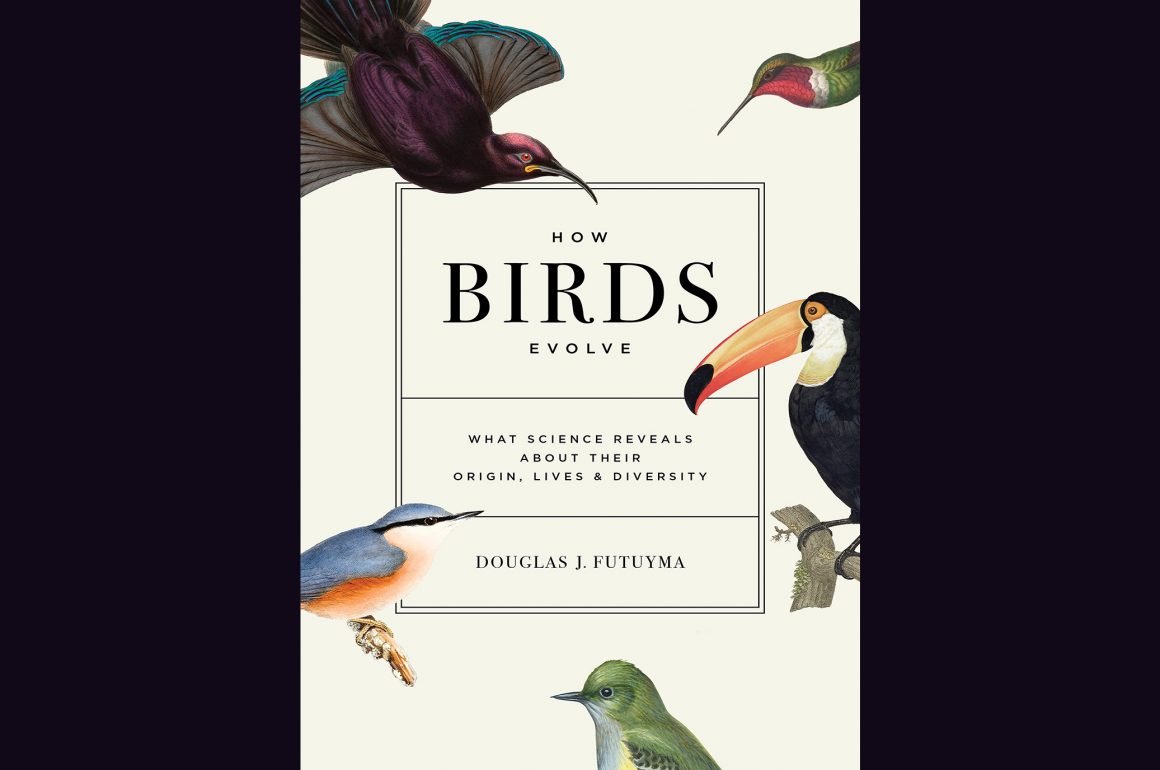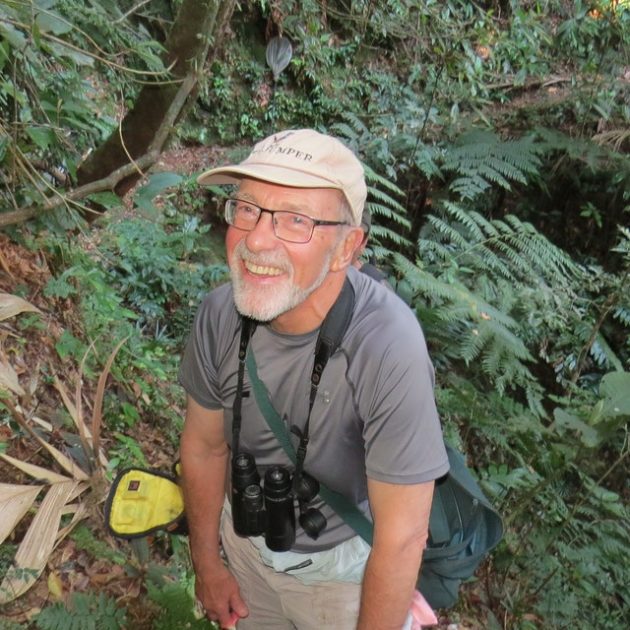
Doug Futuyma believes in science and in the scientific basis of evolution. This shouldn’t have to be stated, especially in a book on bird evolution by an evolutionary biologist with a Ph.D. in zoology, but these are crazy times and it’s probably good to set up expectations. He also believes that we are living in an era of incredible scientific research, one in which new genetic technology and findings from diverse scientific disciplines have turned assumptions upside down, opened up new lines of thought, and provided answers, or at least probable answers, to many of our questions about why birds do the things they do. Most happily, from my point of view, Doug Futuyma believes that people like you and me–birders and nature enthusiasts and the nonstop curious–can understand the more complex ideas behind evolutionary science, and that this knowledge will enhance our appreciation of birds’ often crazy behavior which will, in turn, make us more mindful of what we need to do to give them a future.
How Birds Evolve: What Science Reveals about Their Origin, Lives, and Diversity by Douglas J. Futuyma is a synthesis of theory and research about evolution and birds. But, ‘synthesis’ is a dry word, and this is a book with a quiet yet firm personality underlying its words. Doug Futuyma is a Distinguished Professor Emeritus in the Department of Ecology and Evolution at Stony Brook University, State University of New York, and he has taught much of this material to undergraduate and graduate students, and also birders in later years, for literally decades. Doug is not an ornithologist, he is an evolutionary biologist, the author of a leading textbook on the subject. He is also a serious birder (and a birding friend), and his birding observations and adventures are used throughout the book to introduce evolutionary questions and illustrate the mental interplay between personal experience and scientific curiosity.
The book is smartly organized into 12 chapters. The beginning chapters give us a framework of scientific thought (theory of evolution and birds, the basics of using DNA to determine taxonomic relationships, the paleontologist’s case for bird evolution); the next six chapters focus on specific aspects of bird behavior and how they have been shaped by evolution; the last three explore big questions of species, distribution, extinction and the future.
The six middle chapters are my favorite reading. Each chapter is entitled with an unlikely bird pair : Finches and Blackcaps: How Bird Populations Change and Adapt; The Ruff and The Cuckoo: Variation Within Species; Hoatzin and Hummingbirds: How Adaptations Evolve; Owls and Albatrosses: Life Cycle Events and Variations; Auklets’ Crests and Peacocks’ Trains: Sexual Selection in Birds; Anis, Swallows, and Bee-eaters: The Social Life of Birds (o.k. that’s three birds). The text goes far beyond just those two birds, however, as Doug works his way through the puzzles presented by the incredibly wide diversity of bird behavior, even within species, citing current research and new and old theories, reasoning out the most likely and unlikely answers. I felt like this was a good next step after a year of bird books that have focused on bird behavior as it has been observed by ornithologists. Here are good, complex questions about why this diversity exists, how it came about, and what is its function when it comes to species and overall avian survival.
The material is sometimes a challenge to read. Though it is written for lay people, there is a lot of background theory and scientific history that we need to know to understand the subject, and no one wants to read a book 1,000s of pages long, so the text sometimes appears to be traveling on a circuitous journey and complex topics are condensed into a couple of paragraphs. I needed to read some sections more than once to get the gist. This isn’t a bad thing, it’s just a very different kind of book than popular books about bird behavior, which rely on story as much as science. This is a book that requires attention.
The “Owls and Albatrosses” chapter, for example, begins with Doug’s personal experiences observing of the nesting strategies of Malleefowl and a Moluccan Megapode, Australasian “chickens who lay their eggs in unusual ways and do not parent. At all. He then presents the question of the chapter: “What are the conditions under which…various life histories would be advantageous and likely to evolve by natural selection?” (p. 109). (“Life history” here means the strategies a species employs from birth to death.) This is followed by a very quick condensation of the work of British ornithologist David Lack on natural selection and clutch size, then by a summary of experiments, including one on Collared Flycatchers in Sweden. We then get to the Albatrosses and their reproductive lives, the entryway to thinking about the relationship between reproductive effort and life span. And then we go back to the evolution of clutch size. Doug looks at the differences between tropical and temperate-zone songbird clutch size (tropical birds tend to have fewer eggs) and factors that would influence number of eggs and nestlings–predation, life span, extrinsic mortality, food delivery, signals employed by the nestlings themselves. The concept of offspring competition is illustrated by descriptions of experiments with American Coots (the babies with longer orange plumes attracted the most parental attention) and Great Tit chicks (chicks with red mouth linings got, and then gets into those species who practice sibling homicide, including Black-billed Magpie and Whooping Crane. This is followed by tales of birds like Barn Owls and Rockhopper Penguins, whose over-reproductive habits practically guarantee that some nestlings will die. There are three hypotheses about why this happens; Doug lays them out and gives his opinions; he favors one hypothesis (for many, not all birds)–good years and bad years–and uses Snowy Owls as an example, which immediately wins me over. We are now two-thirds into the chapter, Doug then suggests a break. I breathe a sigh of relief, knowing that it’s not just me. It’s a lot of information concentrated into 11 pages. But when you read it, it makes sense. There are a little detours along the way and they are there for a reason, to give us nonscientists the necessary background and criteria with which to understand the evolutionary scientific way of making sense of the natural world.
In Chapter 11, simply entitled “A World of Birds,” Doug explores tough questions about bird diversity around the world: Why are hummingbirds in tropical America and sunbirds in Africa, Asia and Australasia? What does it mean that a hummingbird fossil was found in southeastern France? Did flightless giant birds evolve from one ancestor and then spread to their now home countries in Africa and Australasia or is there another explanation? Why are all the real tanagers in tropical America? In other words, how can we explain a distribution of species that often seems serendipitous and weird. (If this wasn’t a book about science, I’d say that it was deliberately planned by the nature gods to encourage birding tourism.) The answers involve phylogenies, evolutionary family trees, derived from DNA studies combined with fossil records, and geological concepts of how the continents and oceans were formed from super land masses. I confess, I knew that all the tanagers were in the tropics, but it never occurred to me that there was a possibility of finding answers. If I ever see a Bay-headed Tanager in Costa Rica again, I’ll observe it knowing that its ancestors were from South America and that they are relatively recent arrivals to Central America, having crossed the Isthmus of Panama at the end of Pliocene epoch.
Chapters are generously illustrated with figures, tables and photographs. The figures and tables are part of the text, ranging from two to six per chapter, and illustrate the concepts and research explained in the text, often derived from the source research articles. For example, the “Owls and Albatrosses” chapter has 6 figures, including “a slightly mind-stretching model of the evolution of parental care” comparing the ‘female-only care’ of hummingbirds to the ‘both care’ of Atlantic Puffin to the ‘male-only care’ of the Northern Jacana (7.4, p. 120). Many of the graphs and diagrams are enlivened by bird drawings by Luci Betti-Nash and Stephen Nash; this works particularly well with the phylogenies, the ‘family trees’ of bird lineages. There are even some figures that are all artwork; Nash’s drawing of the Wrybill and its asymmetrical bill (fig. 4.4, p. 70) is adorable as well as educational. The 48 color plates of photographs are grouped together in one glossy paper section These are field photographs, some by the author, others by friends, colleagues, and tour leaders, and they aptly illustrate many of the anecdotes, research accounts, and bird examples given in the text. The text itself refers to the plates in all the appropriate places. I also adore the jacket cover, an elegant composition of historical bird images.
The text is also carefully footnoted. the Notes section is worth perusing, for both the citations of research and Doug’s comments on the sources and the research itself. All books and articles are noted in brief format, which means if you want to know the complete citation, not just the author and year, then you need to consult the Bibliography. This 26-page section of approximately 520 citations of scientific journal articles and books, ranging from Darwin’s The Voyage of the Beagle (1839) to journal articles on extinction and climate change (2020) can be said to be the definitive bibliography on birds and evolution.
There is no glossary, which I initially missed. I then discovered a glossary workaround. He states in the Preface that he has used as few technical terms as possible, though some are necessary, and he is very careful to give definitions throughout the book. Some of these are scientific words, like ‘phylogeny’ and some are common words like ‘fitness’ that mean something different and specific when talking about evolution. These words and others are listed in the Index, with page numbers given for their definitions. So, no glossary per se, but you can look them up quickly in the Index, which is almost the same thing. The Index itself is very good, allowing the reader to look up concepts, birds, and people, and with cross-references from scientific species names to common names.
How Birds Evolve: What Science Reveals about Their Origin, Lives, and Diversity by Douglas J. Futuyma is a smartly constructed, quietly passionate book about evolution and bird diversity and species distribution, about how feathered dinosaurs became birds and then why some very large birds lost the ability to fly; about why the process of natural selection produces species who cooperate in child rearing and species who parasitize other’s nests and even species who do no parenting at all. It is also about science itself, how scientists from different fields approach evolutionary questions in very different ways, for example whether proof that a Wrybill’s asymmetrical bill is a product of adaptive evolution lies in biological experimentation or the tools of functional morphology or an evolutionary comparative approach. It’s a fascinating and challenging book by a scientist who understands birders because he is one.
How Birds Evolve: What Science Reveals about Their Origin, Lives, and Diversity
by Douglas J. Futuyma
Princeton Univ. Press, October 2021
ISBN-10 : 0691182620 ISBN-13 : 978-0691182629
hardcover; also available in eBook and Kindle formats
32op.; 6.12 x 9.25 in.; 48 color + 67 b/w illus. 4 tables.; $29.95














Leave a Comment